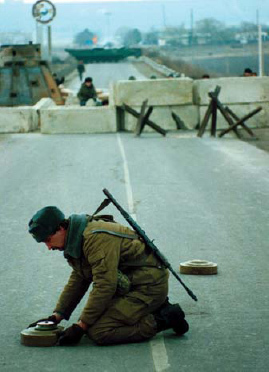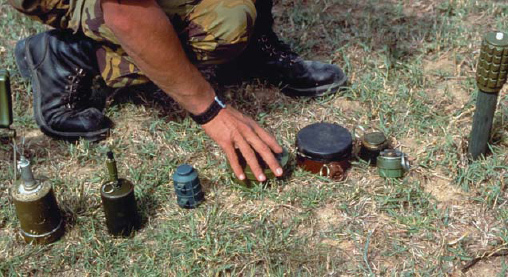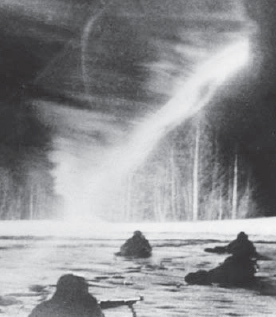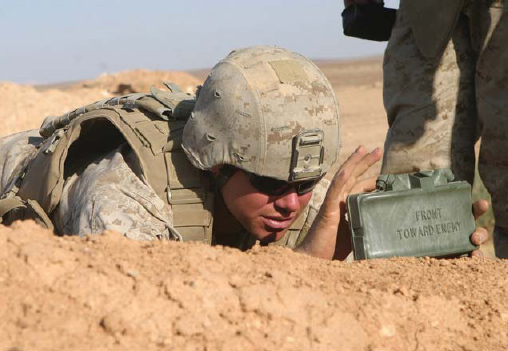
Moldavia National Guards surface-lay Russian-type anti-tank mines on a bridge to prevent tanks crossing the Dniester River – a contested piece of land following the collapse of the Soviet Union. Russian anti-tank mines have been used against ISAF forces in Afghanistan but increasingly IEDs are the primary threat. (Topfoto)
Skill: How do you use the weapon to maximum efficiency?
In conventional warfare mines are laid out by engineers in certain patterns and areas to slow, funnel or deny access to attacking forces. I have covered this in a later chapter. If you are going to use mines in a counter-insurgency or false flag role when working as Special Forces then see the section later where I show how they are used.
Types of landmines
There are hundreds of types of both anti-personnel and anti-tank mine available all over the world. These come in all shapes, sizes and with varying degrees of effort built in to make them difficult to find and/or move. They are all pretty much the same from the principle of use and avoidance as we will see shortly.

Various types of AP mine. The one on the far right sits above ground with a trip wire and gives everyone a piece. (Corbis)
Summary: What are the important things to remember about mines?
In an effort to make sense in this book I have shown you how shop-bought mines work here. Later I will explain the tactics used with and against both mines and IEDs together. This is because in counter-insurgency warfare the use of mines overlaps with IEDs/home-made bombs.
PERSONAL EXPLOSIVE DEVICES
There is a whole range of explosive toys which you will come across as a soldier and, you will be pleased to hear, there are even more available to the Special Forces operator. In this chapter I will give you an overview of the most common so you know what they are and how they can be used for your benefit. The devices which I am discussing here are the shop-bought items with which you may well be issued. They fall into two main categories: lighting up the enemy and killing him.
Lighting up the enemy
With the development of night-vision technology in the last couple of decades the use of flares of various kinds might seem to be on the wane. To a great extent this is probably true but for the sake of a little ink you might as well know what can be achieved by you or the opposition in this area. Remember the opposition might not be so well equipped with night-vision equipment as you are and might decide to light up the night so they can see to shoot you. If you are lit up by some incendiary device at night it is often better to freeze than move because the light they give off is of a type which makes colour vision, and therefore identification of a stationary object, difficult but allows movement to be spotted easily. If you find yourself in a situation where the enemy have night-vision equipment and you do not then frankly it is time to take your ball and go home.

SS ‘Totenkopf’ troops go to ground and freeze as a Russian flare bursts over a patrol in Demyansk, 1942. The principles of how to use flares on the battlefield haven’t fundamentally changed in 70 years. (Cody)
Rockets: When you think the enemy are approaching you can send up a type of rocket, which will burst in the air like a firework and light up the whole area for a matter of some minutes as it descends by parachute. Certainly for long enough to make anyone approaching wish they were elsewhere. The benefit of rockets is that they do not have to be set up in advance at the site of the required illumination but may be deployed over an area which you have neither visited nor control. A disadvantage, compared to night sights, is that the enemy have a good idea that you have seen them coming.
Ground flares: As an alternative to rockets, when you have the opportunity to set them up along those lines of advance which you expect the enemy may use, are ground flares. These are stubby cylinders the size of baked bean cans which may be attached to a metal stake and set in the ground. They are set off by either a pull on a cord or battery and wire.
By far the most useful feature of a ground flare is not really the illumination. It is that it can be set up, say, outside your base perimeter, with a gun covering it and the pull cord to set it off can be used as a trip wire. This way when the enemy approach they warn you by setting off the flare and then you have light to shoot them by. A tireless sentry which is economical and convenient as they weigh only a few ounces. Not as good as a Claymore though.
Neutralizing the enemy
There is a very popular explosive device which is much spoken of by those who have never used one. This is the Claymore Mine. It is not a ‘mine’ in the popular meaning of pressure-detonated landmine. Rather it is a type of shaped charge which is mounted above the ground on small, wire legs and detonated by wire and battery. I will speak of it at length here it is very useful and there is a whole range of similar devices which you will then understand.
The Claymore is an explosive charge shaped in such a way that the greater part of the blast is directed to propel shrapnel horizontally in a chosen direction. Claymore – as in the Scottish heavy cutting sword – is an appropriate name for this weapon as it cuts straight through any bodies within its range and the original was invented, appropriately, by a Scotsman named McLeod.
Picture a segment of an orange made of explosive only less curved. Imagine that the part which would have been next to the peel has a layer of shrapnel embedded in it. Then imagine the whole is wrapped in a waterproof casing with a hole in the top for a detonator and holes at either end, underneath, for the insertion of wire legs. A Claymore looks nothing like this but the idea is sound.
TOP TIP!
How to use Claymores effectively
To set up a Claymore pick a site where the mine can stand and point along a track towards oncoming enemy pedestrians. Remember there is a severe back-blast from a Claymore.

Instructor arms a Claymore mine. If this were not a demo with a plastic mine there would be no one else close by. Trust me on that. (USMC)
The effect of a Claymore is somewhat like a hundred shotguns all firing together in the same direction. The blast and shrapnel will cut a wedge something like 30° wide from floor level rising at something like 20° and, depending on the model, kill anything out to over 100m. These figures are not exact but simply based on the countless times I have used them. If all else fails read the handbook.
Open up the two pairs of wire legs and fix them into the base. Stand the mine where you want it to go remembering to point it the right way. It does say on the cover which side you point at the target area. Indeed, on the original mine, it said, ‘Front towards enemy’ for the hard of thinking. Try to get it right every time.
You can either set up the mine to be triggered by a trip wire or by a command detonation where you make the battery contact yourself.
Whatever you do remember this next bit: Lay out the wire from your firing position to the mine. At each end of the double wire, twist the two strands together to earth any residual static charge as this may be enough to set off a detonator. I once saw a detonator set off because this was not done. Fortunately it was not in a charge at the time but it frightened me half to death and earned the negligent person a sound beating.